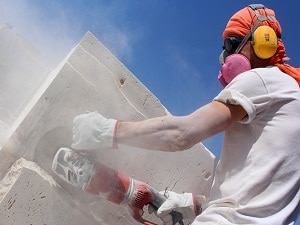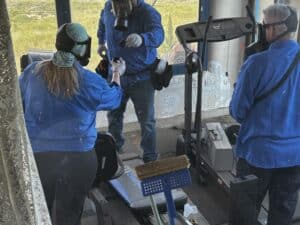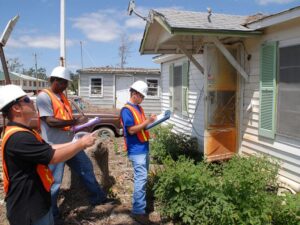Respirable Crystalline Silica: The Health Risks of Exposure

A recent outbreak of silicosis cases reported among engineered stone workers in several states has prompted an investigation into workplace exposure controls.
Eighteen cases of silicosis among stone fabrication workers had been reported at the time of publication of a report by the Centers for Disease Control and Prevention on Sept. 27, 2019. These cases, including two fatalities due to the disease, originated in California, Colorado, Texas, and Washington. In addition, some of the patients had symptoms of autoimmune disease and tuberculosis infection typically associated with silicosis.
One patient who had cut, ground, and polished engineered stone for close to 10 years was found to have been exposed to respirable (inhalable) crystalline silica at concentrations 22 times greater than the permissible exposure limit (PEL) during a workplace inspection conducted by Cal/OSHA in 2009. He was later diagnosed with silicosis and concurrent scleroderma, an autoimmune disease, before passing away at age 38. This tragedy, echoed in several other workers affected by this outbreak, is preventable through effective exposure controls and training to minimize exposures in the workplace.
Health Effects of Exposure to Respirable Silica
The primary route of exposure to respirable crystalline silica (RCS) is the inhalation of fine silica-containing dusts. These particles may be less than 10 micrometers in diameter – less than 1/5th the width of a human hair – and are able to deposit deep in the lung tissue. In the lungs, silica particles can pose a major risk to human health, and may lead to the development of several adverse health outcomes, including:
- Silicosis: an inflammation and scarring of the lung tissue that occurs following either a short term, high concentration exposure or long-term, low-level exposure to RCS.
- Lung Cancer: the International Agency for Research on Cancer (IARC) classified RCS in quartz or cristobalite forms as a Group 1 human carcinogen in 1997.
- Airway Disease: silica exposure can lead to diseases such as chronic obstructive pulmonary disease (COPD), which includes chronic bronchitis and emphysema, and may be independent of silicosis.
- Other Diseases: silica-related diseases can be complicated by infections such as tuberculosis. RCS exposure has also been linked to autoimmune diseases and chronic renal disease.
Engineering Controls and Respiratory Protection are the Keys to Worker Safety
Exposure to respirable crystalline silica can cause several serious health outcomes, particularly in those who work with silica-containing materials, including many construction trades. However, these effects are largely preventable through the utilization of engineering controls including the use of wet methods and adequate ventilation, along with the proper use of personal protective equipment such as respirators.
Omega’s qualified staff can conduct a job site exposure assessment to ensure employers are complying with OSHA workplace standards and controlling silica dust release to well below permissible exposure limits. Omega’s team of experts can create a silica exposure control plan designed to meet employers’ unique needs.
Contact us to learn more about how an RCS exposure assessment and silica control plan can help ensure regulatory compliance and workplace safety.
Contact Us to Learn More About Environmental Assessment
References
Hnizdo, E., & Murray, J. (1998). Risk of pulmonary tuberculosis relative to silicosis and exposure to silica dust in South African gold miners. Occupational Environmental Medicine, 55, 496-502.
International Agency for Research on Cancer (1997). IARC monographs on the evaluation of carcinogenic risks to humans, Volume 68. Silica, Some Silicates, Coal Dust and Para-Aramid Fibrils. Lyon, France: IARC; 1997. Available from: http://publications.iarc.fr/download/2209/c827.pdf
International Agency for Research on Cancer (2012). A review of Human Carcinogens, Volume 100C. Arsenic, Metals, Fibers, and Dusts. Lyon, France: IARC; 2012. Available from: https://www.monographs.iarc.fr/wp-content/uploads/2018/06/mono100C.pdf
Neukirch, Francoise & Cooreman, Jacqueline & Korobaeff, Myriam & Pariente, René. (2010). Silica Exposure and Chronic Airflow Limitation in Pottery Workers. Archives of environmental health. 49. 459-64. 10.1080/00039896.1994.9955001.
Pollard, K. M. (2016). Silica, Silicosis, and Autoimmunity. Frontiers in Immunology, 7. doi: 10.3389/fimmu.2016.00097
Steenland, K., Mannetje, A., Boffetta, P. et al. Pooled exposure–response analyses and risk assessment for lung cancer in 10 cohorts of silica-exposed workers: an IARC multicentre study (2001) 12: 773. https://www.doi.org/10.1023/A:1012214102061










